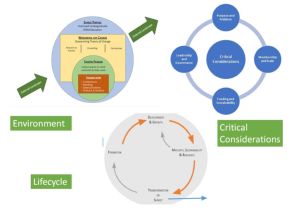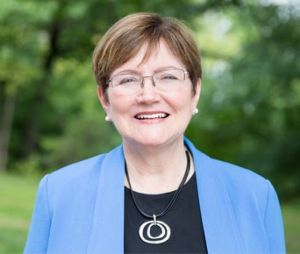The Advanced Technological Education program is one of six postsecondary education networks that National Science Foundation-funded researchers have studied to understand how institutional change occurs to improve teaching.

Of the six organizations in the Organizational Change Networks study, ATE is the only one that solely targets associate-degree-granting institutions. Other aspects of ATE that attracted the researchers’ attention are the inter- and cross-discipline collaborations within the program, its projects to mentor new STEM education leaders, and its built-in partnerships with employers in multiple industry sectors.
“That’s why it’s so fascinating,” said Susan Rundell Singer, co-principal investigator. She added, “It’s more than a network of networks. It’s got these really deep relationships and overlapping types of networks, and that’s why we were fascinated by it.”
The study is led by Ann E. Austin, interim vice provost for Faculty and Academic Staff Affairs as well as University Distinguished Professor at Michigan State University, and Singer, who became president of St. Olaf College on June 1. Singer had been vice president for Academic Affairs and provost at Rollins College since 2016.
During a Zoom interview Austin and Singer shared their hope that the framework and their other findings will help educators who are forming or managing networks plan their responses to challenges. Adam Grimm, a postdoctoral research associate at Michigan State, also participated in the interview.
OCN Researchers’ Findings

Since 2017 the researchers conducted interviews and observed the six organization-focused change networks. One of their key findings is that “critical challenges play out at every stage, but in different ways,” Austin said. For example, how leadership and decision-making occurs at the outset affects every stage of a network’s lifecycle. Meanwhile, sustainability, membership, and governance are recurring challenges that vary in degree of intensity at different lifecycle stages.
Another finding is that dynamic environments affect networks’ purposes at the same time that the networks are impacting and changing their environments.
The project concludes this year with the researchers putting the finishing touches on more peer-reviewed papers, a toolkit, and a book that translates their scholarly work into guidelines for educators. (The project’s previously published research reports are posted on its website.)
Singer describes the potential benefit of these publications this way: “If you are going to go to a national network, what could you anticipate? How do you get out in front of it so you that you leapfrog over the common challenges that people encounter and you can get where you want to go faster and serve the community you value so much faster and better.”
Singer and Austin, who took leaves from university roles to work at the National Science Foundation (NSF) about ten years ago, said they think NSF reviewers could use the OCN framework when evaluating grant proposals for networks. Singer was division director for the Division of Undergraduate Education from January 2013 through July 2016. Austin served as a program director in the Division of Undergraduate Education from January 2015 through October 2016.
Analysis of ATE

For their analysis of the ATE program, the researchers focused on three ATE Centers: the Florida Advanced Technological Education Center (FLATE), National Convergence Technology Center (CTC) and the National Resource Center for Materials Technology Education (MatEdU). They also gathered information about MentorLinks, Mentor-Connect, ATE Central, and EvaluATE.
The five other programs included in the study are Bay View Alliance (BVA); Center for the Integration of Research, Teaching, and Learning (CIRTL); Network of STEM Education Centers (NSEC); Partnership for Undergraduate Life Science Education (PULSE) Fellows Network; and Reinvention Collaborative (RC/now UERU). All of them and ATE are NSF-funded STEM education improvement initiatives.
Representatives of all the organizations met in person for a “knowledge exchange” with the research team in March to provide feedback on the OCN framework and to learn from each other. The project had previously convened one virtual meeting with all the participant organizations.
Prior to the in-person meeting, most of the study participants from four-year institutions were unaware of ATE.
Grimm said, “We’ve learned a lot from ATE and that knowledge exchange was a wonderful opportunity to learn from the experiences ATE has had and how that might inform similarly situated, but differently organized networks.”
Singer Sees Opportunities for ATE
Singer pointed out the potential for the four-year institutions to learn from ATE’s successful partnerships with industry and its mentoring of new leaders.
She said, “The learning opportunity is how to build a truly collaborative community that welcomes people in. If you come from a more research-oriented culture the currency of the realm is such that it’s just not rewarded, or recognized, or valued in the same way. And yet the folks we’ve studied with within our networks are hungry for that. They want to create those relationships in their own networks and within their institutions. So I think the collaboration, the collaboration with industry, and the letting go of something in a way that’s generative for the next generation and focusing on how what’s core to the work can continue, but maybe in a different form.”
She cited Mel Cossette’s transition from principal investigator of the National Resource Center for Materials Technology at Edmonds College to co-principal investigator of the Micro Nano Technology Education Center at Pasadena City College as an example of an ATE program leader sharing their knowledge and experiences to benefit a “whole new national network in a completely different area.” Through Mentor-Connect, Cossette also formally mentored faculty who were new to ATE, including Jonathan Beck who became the principal investigator of the National Center for Autonomous Technologies at Northland Community and Technical College.
“As we look at the intersection of sustainability, lifecycle, and these critical challenges, ATE has offered a really interesting model for how the intersecting parts of the framework come together over time,” Singer said. She went on to explain, “The overall model of how networks actually function in healthy and productive ways mirrors not just what we’re seeing with ATE, but that would be very helpful in some of the mentoring networks we are seeing with ATE and the leadership development parts that ATE is trying to support at this point.”
Austin’s ATE Takeaways
Austin listed several aspects of ATE that stood out to her. First, is its consistent focus on preparing students for the technical workforce in collaboration with industry in ways that have been both flexible and responsive to employers’ needs. “It has been able over a number of years to retain a focus and also to be adjusting that all the time,” she said.
She thinks there are lessons to be learned about the way NSF program directors structured the ATE solicitation from the beginning with “clear parameters.”
She pointed to ATE’s collaborations with non-higher education entities and grantees’ approaches to sun-setting—when their NSF grant funding concludes—as noteworthy.
“The value of interacting very purposefully with industry obviously serves the ATE goals, but I think it just exemplifies that connection outside of the higher ed world can be very, very valuable. And I think the four-year institutions could learn from that,” she said.
“I think ATE is a very good example of how to change over time and not be afraid of closing something—sun-setting,” she said.
 Subscribe
Subscribe


 See More ATE Impacts
See More ATE Impacts
Comments
There are no comments yet for this entry. Please Log In to post one.